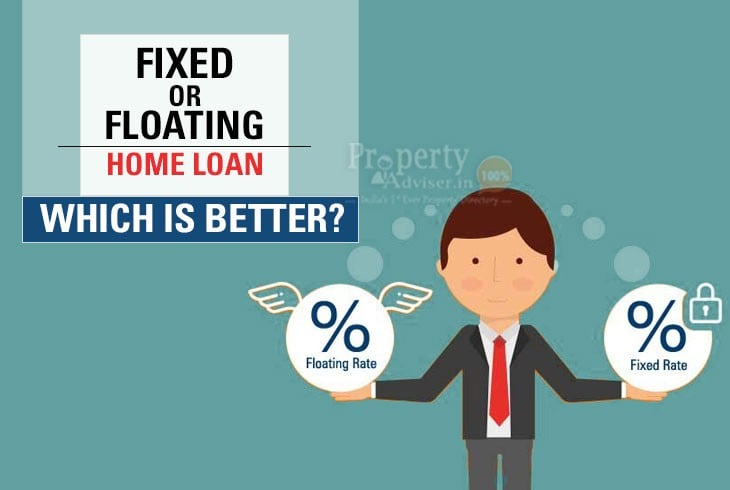Home loan is like an angel for those looking to buy or build a house, except that there is a lurking worry about the interest component on the loan. The goal is always to minimise the interest payment.
Many people are not aware that there are two kinds of interest rates - fixed interest rate and floating interest rate. You can choose either of the two - each one has its own set of advantages and you can decide based on what you feel would work best for your situation.
Read on to understand what is fixed interest rate and what is floating interest rate, and what is the difference between fixed and floating interest rate.
What is Fixed Interest Rate
As the name suggests, this is an interest rate which is “fixed”. That is to say, you will be consistently paying the same interest rate that was mentioned in the terms of the loan, for the entire period of the loan repayment.
What is Floating Interest Rate
A floating interest rate in one that keeps changing based on the market fluctuations, and as such, you would be paying a different rate of interest at different times during the loan repayment period.
Fixed Vs Floating Home Loan - Which One to Choose?
That would naturally depend on your understanding of the benefits of each of these - fixed and floating rates, and the difference between fixed and floating interest rate.
Understanding How Fixed Interest Rate Works
|
Advantages of Fixed Interest Rate |
Disadvantages of Fixed Interest Rate |
|
The interest rate is fixed irrespective of market changes. You will be benefited if the market rates increase, as you will not be charged higher interest rates. |
Fixed interest rate is generally 1% to 2.5% higher than floating rates. |
|
There is a sense of security against market fluctuations, as that will not impact your interest component. |
If the market rates drop, then you will be missing out on the lower interest rates, as you would have to pay the fixed interest rate which is higher than the prevalent interest rate at a given time. |
|
EMIs are fixed. |
|
|
Since you know beforehand exactly how much interest you need to pay, you can plan your finances, budgets, and IT accordingly. |
If you foreclose the home loan, then you would need to pay prepayment penalty (ranging from 2% to 2.50%), if you choose a fixed interest rate. |
|
It is difficult to move to other lenders in a fixed interest rate, as prepayment charges would apply. |
|
|
Fixed interest rate is not always transparent, as banks may have clauses that after a certain period, floating interest rates will apply. |
Understanding How Floating Interest Rate Works
|
Advantages of Floating Interest Rate |
Disadvantages of Floating Interest Rate |
|
Interest rate is generally 1% to 2.5% lower compared to fixed interest rates, and therefore you can save money. |
At times, because of market fluctuations you may temporarily end up paying more interest rate than the fixed rate. |
|
Fluctuating market rates can work to your advantage and overall you may be able to reduce the interest component. |
There is a risk factor because of the uncertain nature of markets. |
|
If you foreclose the loan, you don’t have to pay any prepayment penalty, and this is another big plus! |
EMIs change depending on the prevalent interest rates. |
|
If other lenders are offering lower rates, you can easily switch lenders, as there are no prepayment charges in floating interest home loan. |
You cannot plan your finances and IT optimization effectively, because of the floating interest rates. |
Ultimately Floating or Fixed Home Loan - Which is Better?
Now that we have understood what is fixed interest rate and what is floating interest rate and what is the difference between fixed and floating interest rate, we can see, there are benefits in both fixed rate and floating rate. Both the options also have some downside. You need to think what might work best for you, and it is totally your call. Take care to read in detail the terms offered by your lender for fixed and floating rates, and weigh both the options to see which one has better benefits for your situation.
Additionally, find below some guidelines and some points to keep in mind when you are making the decision.
When Should You Opt for A Fixed Interest Rate Home Loan?
- Fixed interest rate works best for short term home loans such as 3 to 10 years
- It also works better if you are in the 40+ age group, as you would look for more certainty at this stage, and you are comfortable with the fixed EMIs..
- This is a better choice if you are not conversant with how the real estate markets work.
- Fixed interest rate is suitable if you want a smooth sailing that is predictable, rather than saving on interest component.
When Should You Opt for A Floating Interest Rate Home Loan?
- Go for this if you are well versed with the real estate market.
- If you are in your 20s or 30s, then, again, you might want to take chances, and avail the benefits of prospective fall in interest rates.
- If your goal is to save on an interest component, and you don’t mind taking a little bit of chance, then floating interest rate will be helpful to you.
Combined Interest Rate Home Loan
If you are still confused whether you should go for fixed interest rate home loan or floating interest rate home loan, and want to avail the best of both the worlds, then you can go for a combined loan, also known as’ time-bound fixed interest rate’. In this scenario, a fixed interest rate would apply for the first few years ( such as 3 to 5 years or more), and a floating rate would apply for the rest of the loan term.
Shifting from Fixed to Floating & Vice Versa
Even after making your choice, do not worry, that is not the end of the road. You can always shift from fixed rate to floating rate and vice versa even mid-way of the term, as most lenders allow that. You can seek clarification from the lender on whether they allow such shifting, before you go ahead and make the decision.












